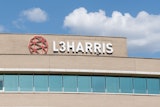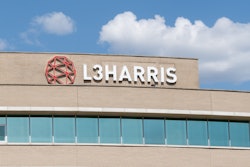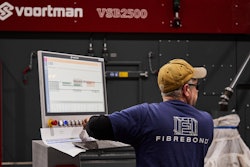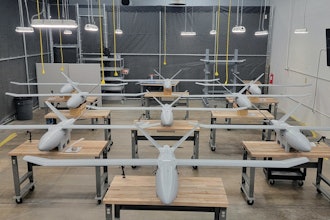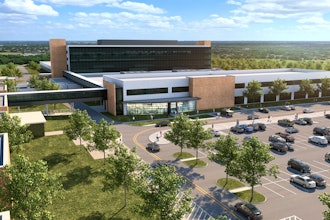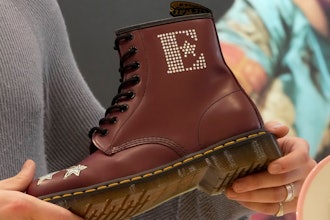Contract fabricating shop Stock Manufacturing, in Harrison, OH, found itself running out of laser cutting capacity. But instead of adding a third machine, the owners elected to add more hours of productivity to their two Cincinnati Inc lasers, becoming the first customer for Cincinnati's newly developed, automated material handling system. Installed in late 2004, the Modular Material Handling System (MMHS) allows the two lasers to run 8 hours a day attended and another 12 hours unattended, plus long periods unattended over the weekend, as workload requires.
"By our analysis, this was a four for the price of three deal," says Dennis Stock, one of three brothers who own and operate the business. "The automated system cost us about the same as a third laser would have," he explains. "We're now getting productivity equal to four lasers running two shifts a day, while staffing just for two machines."
How the System Works
The MMHS features two towers offering 38 drawers of storage for sheet material and finished parts. Each drawer provides 4.5 in. of stack height and holds up to 6,000 lb of material. An elevator system located between the towers delivers sheet material to a gantry-driven robot for transport on overhead rails to the appropriate dual-pallet laser. The robot loads the sheet onto the open pallet. When that pallet advances into the cutting zone, the pallet with the completed job cycles out and the robot removes the finished parts. The automated pallet change limits laser beam-off time to seconds, keeping laser utilization near 100%.
The robot transporter features an arm with long, closely spaced fingers to support and control the sheets. Stock added its own creativity to the process, programming in a "pop" when lifting finished sheets. This bumping action breaks loose the parts and any slugs that get welded to the table grid.
Stock's MMHS is configured so that finished parts can be transported to one of three unload stations or back to the elevator for tower drawer storage.
Tower material storage gives the company great manufacturing flexibility in processing a wide variety of jobs for multiple customers on short turnaround schedules, says Stock. "Only four of the drawers store duplicate material," he notes.
The tower stores various grades of mild steel in sizes from 16 gauge to 1/2 in., mainly in 60 x 120 in. sheets. "We've tried to standardize as much as possible on the 5 x 10 ft sheets," says Stock. "We have a few jobs that require 6 x 12 ft."
Manually handling that material mix was a staffing burden. "We used to spend a lot of time getting material ready for the laser," says Stock. "It almost took one person full time just to do that."
In addition to processing versatility, the two towers made economic sense, he says. "You can get the MMHS with one tower, but the real expense is in the elevator," says Stock. "The incremental cost for the second tower was minimal. It's a good investment in terms of flexibility or growth capacity."
Meeting Tight Delivery Requirements
Among Stock's key customers are an automaker and a leading maker of hydro seeders for highways, land reclamation, and large recreational areas. The automotive customer requires delivery with 48 hours on mixed lot orders.
"We give ourselves 24 hours to program and make the parts and 24 hours for the delivery," says Stock.
Located near Cincinnati in the extreme southwest corner of Ohio, Stock is just minutes away from Indiana and Kentucky and three interstate expressways that put nearly every part of the industrial midwest and midsouth within eight hours driving time, he points out. An international airport is only 10 minutes away.
When Stock Manufacturing first decided to add laser cutting, it took a thorough, pragmatic approach to evaluating machines.
"We sent a bid to all laser manufacturers and asked them for a time estimate on processing 15 different parts," says Stock. "Cincinnati came back with the lowest time of all the estimates, about 7 1/2 hours. We took 11 sheets to their showroom for testing. The actual run time was only off by four minutes."
Stock bought its first laser from Cincinnati in 1996 and has upgraded a couple of times to newer models. Today it runs a CL-7A with 6 x 12 ft pallets and a CL-7A with 5 x 10 ft pallets. Both machines are slab lasers featuring Rofin resonators, he noted.
"They don't require blowers or turbines," said Stock. "You can expect blower replacement after 12,000-20,000 hours at $20,000-$35,000. Anytime you've got something turning 30,000-50,000 rpm, you've got the potential for failure. It's a maintenance aspect we prefer to avoid."
The slab laser costs more initially, but this is offset by savings on blower replacement and assist gas usage. A bottle lasts about three months, he says, compared with one a month for fast-axial-flow resonators.
The Cincinnati lasers were ordered in left- and righthand control versions, so the controls can be located side-by-side. With MMHS automated material handling, one operator can easily run both machines. "I told Cincinnati they should provide a free La-Z-Boy® with every system," says Stock.
Basic System Configuration
Modular design allows an MMHS to be configured for automation of 1-4 lasers in a great number of mix-and-match layouts. MMHS systems allow shops to tailor automated sheet and part handling to existing floor space and today's processing needs, while assuring easy expansion and modification as laser activity grows and changes.
Four base systems and an extensive choice of options provide system flexibility to suit individual shop requirements. Systems can be configured for everything from automated load/unload of a single laser to full automation of high-volume production utilizing material storage towers to serve multiple lasers running complex mixes of parts and materials, as at Stock. Engineered, manufactured, and serviced by Cincinnati, the MMHS systems optimize material flow and laser burn time, while enabling long periods of unattended operation.
The basic load/unload configuration, System 1 consists of:
- Manual stack carts for bringing sheet material to the system.
- Automated sheet handler that removes top sheet of material from the stack
- Gantry sheet transporter that carries the sheet over to the laser, loads it onto the open pallet, then removes finished parts after dual pallets switch position.
- Unload station for finished parts, which can be a cart or table.
A range of modular options allow users to expand MMHS capabilities beyond basic load/unload to higher levels of automation, versatility, and productivity:
- Rail-guided transfer cart automatically transports drawers of sheet or finished parts from/to storage locations.
- Bundle handler transfers bundles of sheet from a shipping pallet or skid to a storage drawer.
- Drawer table serves as one-drawer storage table or as a sorting table.
- Working table has quick access storage for two drawers, like a mini tower.
- Storage tower and elevator are for large operations like Stock Manufacturing, especially ones with multiple lasers needing greatest material storage flexibility and capacity. Vertical towers enable the most efficient use of floor space for storage of sheet and finished parts. The primary tower has 8 drawers, with two 5-drawer extensions available. A second tower sharing the same elevator can be economically added, providing up to 20 additional drawers.
Engineered and manufactured by Cincinnati, MMHS systems feature servo-driven components providing simple, accurate, and reliable performance, while eliminating the need for failure-prone limit switches. PC-based touchscreen control offers user-friendly interface, connection to plant MRP systems, and remote Internet access for off-site monitoring and lights-out operation.
